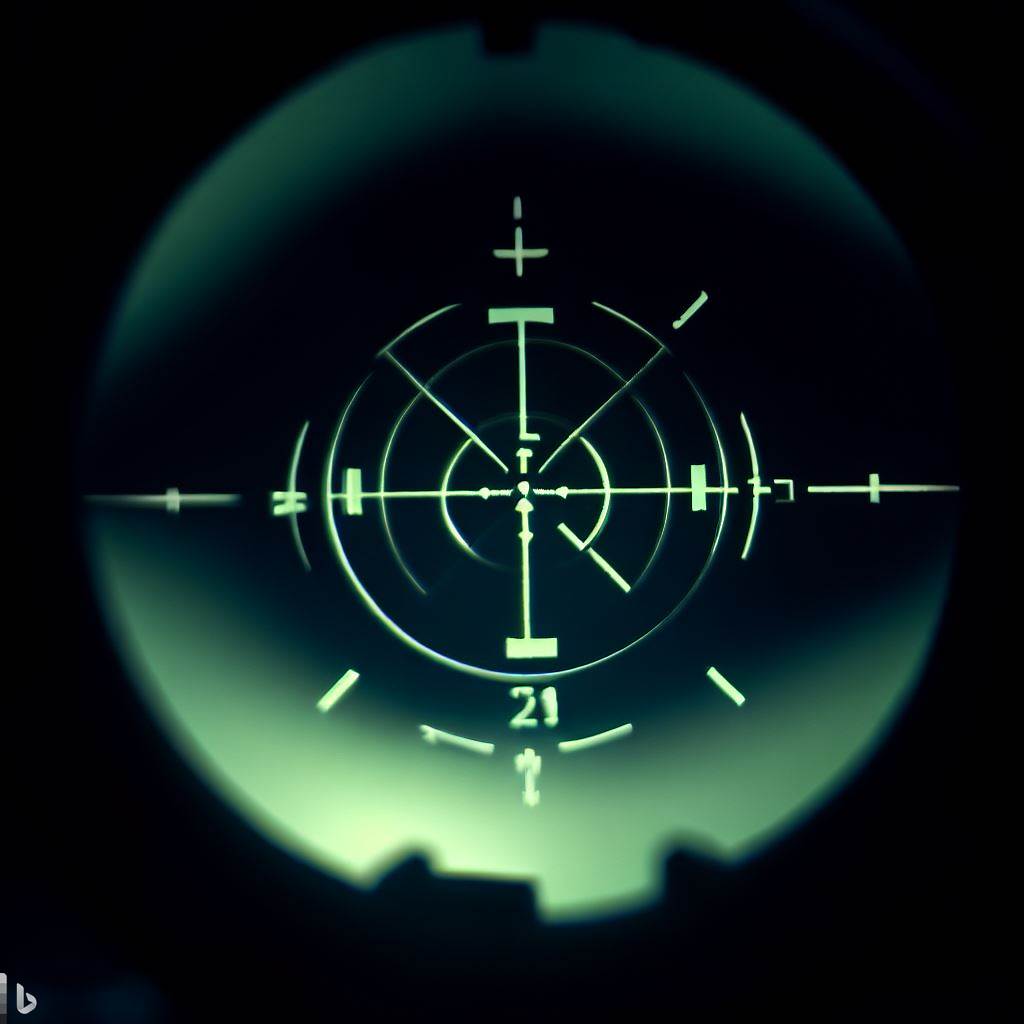

Night vision scopes are essential tools for those who rely on clear vision during low-light conditions. But have you ever wondered what role the reticle plays in these advanced optical devices? The reticle, also known as the crosshair, serves as your guide, aiding in precise aiming and target acquisition.
In this article, we will explore What’s The Role Of The Reticle In Night Vision Scopes? And how it enhances your overall shooting experience. So, let’s uncover the mysteries behind this crucial component and discover its importance in navigating the darkness.
Understanding Night Vision Scopes
Night vision scopes are optical devices used to enhance visibility in low-light conditions or at night. They employ specialized technology to amplify available light, allowing the user to see clearly in darkness. One crucial component of night vision scopes is the reticle, which plays a vital role in aiming, target acquisition, and overall accuracy.
Importance of The Reticle
The reticle in a night vision scope serves numerous purposes that greatly enhance your shooting experience. Firstly, it aids in aiming and target acquisition, ensuring that you can accurately point your weapon at the desired target. With the help of the reticle, you can quickly identify and lock onto your target even in challenging lighting conditions.
Furthermore, the reticle enhances accuracy by providing precise reference points. It allows you to align your shots precisely, ensuring that you hit your target with accuracy and consistency. This is especially important for long-range shooting, where even the slightest error can result in a significant miss.
The reticle also compensates for bullet drop, which is the downward trajectory a bullet experiences as it travels toward its target. By utilizing the markings on the reticle, you can adjust your aim to compensate for bullet drop and ensure your shots stay on target.
Additionally, windage correction is another critical function of the reticle. Wind can affect the trajectory of a bullet, causing it to deviate from its intended path. The reticle provides you with the necessary reference points to adjust your aim and compensate for windage, resulting in more accurate shots.
Furthermore, the reticle allows for adjustments in elevation. When shooting at different distances, it is essential to adjust your aim according to the elevation changes. The reticle’s markings facilitate these adjustments, ensuring that you maintain accuracy over varying distances.
Another advantage of the reticle is its ability to assist in ranging. By using the markings or features on the reticle, you can estimate the distance between you and the target. This is crucial when shooting at targets with unknown distances, allowing you to make the necessary adjustments to ensure a hit.
It’s also important to note that there are multiple types of reticles available, each offering unique advantages. The next section will explore the different types of reticles commonly found in night vision scopes.
Types of Reticles
-
Duplex Reticle: This type of reticle features thin lines that converge into a thicker central crosshair. It provides a clear and unobstructed view of the target, making it popular among shooters.
-
Mil-Dot Reticle: The Mil-Dot reticle consists of dots distributed along the horizontal and vertical lines. These dots serve as reference points for elevation and windage adjustments. Mil-Dot reticles are commonly used by military and long-range shooters.
-
BDC Reticle: BDC, or Bullet Drop Compensator, reticles have hash marks, dots, or lines that help adjust the aim for bullet drop at various distances. This type of reticle is especially useful for shooters who anticipate different ranges.
-
Illuminated Reticle: Illuminated reticles feature backlighting or illumination options, allowing for better visibility in low-light conditions. This type of reticle is particularly beneficial for night vision scopes as it enhances target acquisition.
-
Circle-Dot Reticle: These reticles combine a central circle with a dot or other reticle patterns. They provide a fast and accurate target acquisition, making them popular for tactical shooting and fast-paced scenarios.
Each type of reticle offers unique advantages, so it’s crucial to consider your specific needs and preferences when selecting a night vision scope.
Factors To Consider In Reticle Selection
When choosing a reticle for your night vision scope, several factors come into play. Firstly, consider the application and intended use of the scope. Is it primarily for hunting, tactical shooting, or recreational use? Different activities may require specific reticle features and functionalities.
Next, consider the visibility and contrast of the reticle. Ensure that the reticle appears clear and easy to see against the background, especially in low-light or nighttime conditions. The contrast between the reticle and the target is essential for quick and accurate target acquisition.
It’s also important to consider the weight and complexity of the reticle. Some reticles may be more intricate, featuring additional markings or features that may add complexity to your shooting experience. Assess your comfort level and choose a reticle that suits your preferences.
Reticle Placement And Size
The placement of the reticle within the night vision scope is crucial for optimal shooting experience. Ideally, the reticle should be positioned at the center of the field of view, allowing for easy alignment with the target. This ensures that the reticle aligns with where the bullet will impact, providing an accurate aim.
Additionally, consider the concept of eye relief and eye box in relation to the reticle. Eye relief refers to the distance between your eye and the scope eyepiece, while the eye box is the area within which you can move your eye while still maintaining a proper sight picture. The reticle should be positioned in a way that allows for comfortable eye relief and a generous eye box.
Proper sizing of the reticle is another crucial aspect to consider. The size of the reticle should be suitable for the target distance and the level of precision required. Keep in mind that excessively large or small reticles can affect accuracy and target acquisition.
Reticle Materials And Technology
The two main types of reticles in night vision scopes are wire and etched glass reticles. Wire reticles consist of thin wires that form the reticle pattern and are often found in lower-cost scopes. Etched glass reticles, on the other hand, are made by engraving the reticle pattern directly into the glass, resulting in a more durable and precise reticle.
Night vision compatibility is another important consideration in reticle selection. Some reticles are designed to work seamlessly with night vision devices, allowing for optimal performance in low-light conditions. Ensure that the reticle you choose is compatible with your night vision equipment if you intend to use them together.
The availability of illumination options is another key aspect to consider. Illuminated reticles provide backlighting or illumination options that enhance visibility in low-light situations. Different scopes offer various illumination settings, including brightness adjustments, on/off switches, and even color options. Consider your specific needs and preferences when selecting the reticle illumination features that best suit your shooting requirements.
Reticle Focal Plane
The focal plane of a reticle refers to the location where the reticle appears within the scope’s optical system. There are two main types of focal planes: the first focal plane (FFP) and the second focal plane (SFP).
First Focal Plane (FFP) reticles, also known as front focal plane, adjust in size as the magnification of the scope is changed. This means that the reticle markings remain accurate regardless of the magnification setting. FFP reticles are commonly preferred by long-range shooters as the reticle subtensions remain consistent across different power levels.
Second Focal Plane (SFP) reticles, in contrast, maintain a constant size within the scope’s optical system regardless of the magnification setting. The reticle’s size remains the same, while the target image changes with varying magnification levels. SFP reticles are popular among hunters and tactical shooters who value simplicity and ease of use.
When selecting a reticle focal plane, consider your shooting style, intended use, and personal preferences. Both FFP and SFP reticles have their advantages and suitability for specific shooting applications.
Considerations For Night Vision Compatibility
If you plan to use your night vision scope in conjunction with night vision devices, there are several considerations to keep in mind.
Size and clarity of the reticle are crucial. Ensure that the reticle appears sharp and clear when viewed through your night vision equipment. Some scopes offer specially designed reticles that are optimized for night vision compatibility, providing enhanced visibility in low-light conditions.
Brightness control is another significant consideration. Make sure that the reticle’s illumination settings are adjustable, allowing you to find the optimal brightness level for your night vision capabilities. This ensures that the reticle remains visible without overpowering or hindering your ability to see the target.
Compatibility with IR (Infrared) illuminators is also important when using night vision devices. Some reticles are specifically designed to work in conjunction with IR illuminators, providing optimal performance in total darkness. Ensure that your selected reticle is compatible with IR illuminators if you plan to use them.


Reticle Maintenance and Care
Proper maintenance and care of your reticle are essential to ensure its longevity and optimal performance. Regular cleaning is necessary to remove dirt, dust, or debris that may accumulate on the reticle. Use a soft, lint-free cloth or a cleaning solution specifically designed for optics to gently wipe the reticle, taking care not to damage or scratch it.
Protective covers are also valuable accessories for your reticle. When not in use, keep the scope covered to prevent dust, moisture, or any other potential contaminants from reaching the reticle. This helps maintain the visibility and clarity of the reticle, ensuring its reliable performance over time.
Lastly, proper storage is crucial. Store your night vision scope in a dry and temperate environment, away from extreme temperatures or humidity. Avoid excessive shock or impact, as it can damage the delicate components, including the reticle. By following these storage recommendations, you can prolong the lifespan of your reticle and enjoy consistent performance.
In conclusion, the reticle plays a vital role in night vision scopes, providing essential functions for aiming, target acquisition, and improved accuracy. Choosing the right type of reticle, considering factors such as application, visibility, and compatibility, is crucial for optimizing your shooting experience. With proper maintenance and care, your reticle can continue to serve you well in low-light conditions, ensuring accurate and successful shooting.
GOSKY BAK4 Angled Night Vision Scope Review for Hunters
Gosky 20-60×80 Night Vision Scope Review: Dual Focusing ED Spotting Excellence
How Do I Minimize Noise When Using Night Vision For Hunting?





